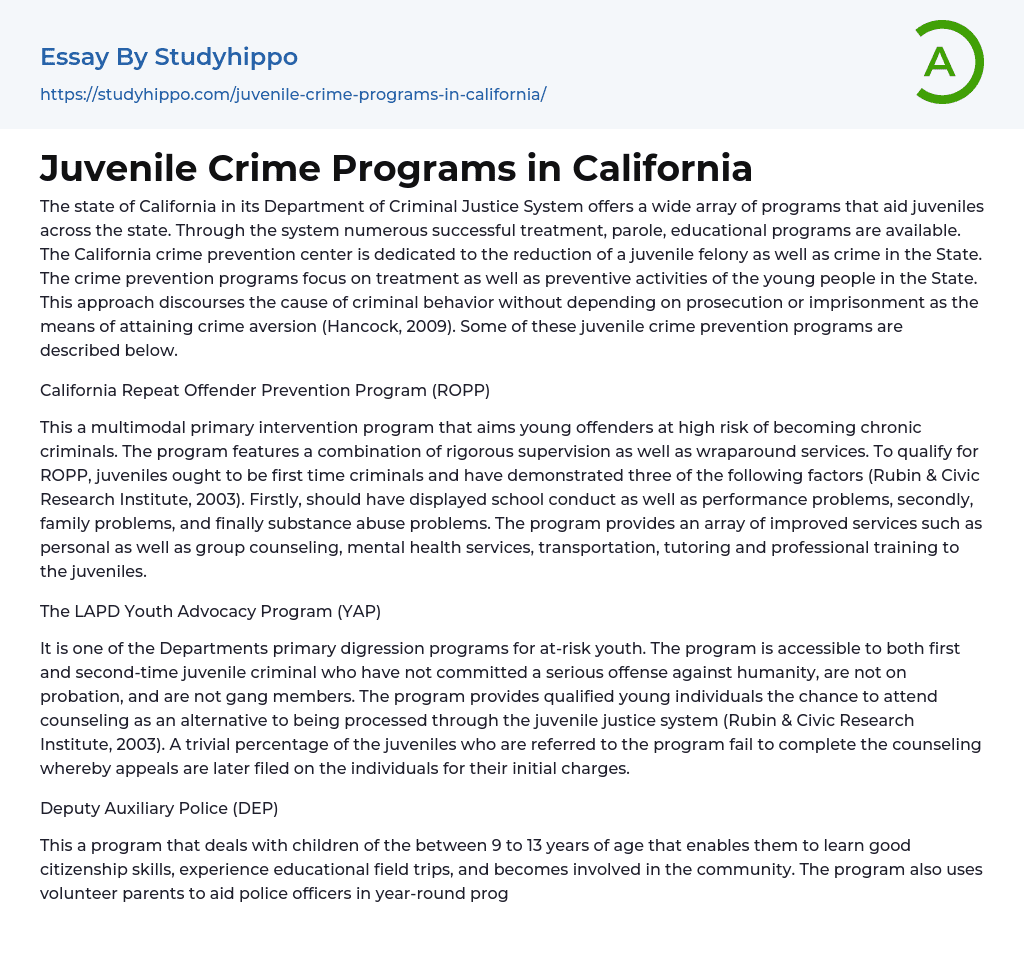The state of California in its Department of Criminal Justice System offers a wide array of programs that aid juveniles across the state. Through the system numerous successful treatment, parole, educational programs are available. The California crime prevention center is dedicated to the reduction of a juvenile felony as well as crime in the State. The crime prevention programs focus on treatment as well as preventive activities of the young people in the State. This approach discourses the cause of criminal behavior without depending on prosecution or imprisonment as the means of attaining crime aversion (Hancock, 2009). Some of these juvenile crime prevention programs are described below.
California Repeat Offender Prevention Program (ROPP)
This a multimodal primary intervention program that aims young offenders at high risk of becoming chronic criminals. The program features a combination of rigorous supervision as well a
...s wraparound services. To qualify for ROPP, juveniles ought to be first time criminals and have demonstrated three of the following factors (Rubin & Civic Research Institute, 2003). Firstly, should have displayed school conduct as well as performance problems, secondly, family problems, and finally substance abuse problems. The program provides an array of improved services such as personal as well as group counseling, mental health services, transportation, tutoring and professional training to the juveniles.
The LAPD Youth Advocacy Program (YAP)
It is one of the Departments primary digression programs for at-risk youth. The program is accessible to both first and second-time juvenile criminal who have not committed a serious offense against humanity, are not on probation, and are not gang members. The program provides qualified young individuals the chance to attend counseling as an alternative to being processed through
the juvenile justice system (Rubin & Civic Research Institute, 2003). A trivial percentage of the juveniles who are referred to the program fail to complete the counseling whereby appeals are later filed on the individuals for their initial charges.
Deputy Auxiliary Police (DEP)
This a program that deals with children of the between 9 to 13 years of age that enables them to learn good citizenship skills, experience educational field trips, and becomes involved in the community. The program also uses volunteer parents to aid police officers in year-round programs. The children partake in field trips, holiday occasions, safety classes, and other activities that focus their time and attention in a constructive as well as positive manner (Rubin & Civic Research Institute, 2003). These activities avert them from becoming a part of fringe gang groups or actual criminal involvement hence reducing juvenile crime cases.
Juvenile Impact Program
The program is for the first time the courts refer criminal. The program necessitates the juvenile to admit to their crime as well as the impact the offense caused. The juvenile then partakes in a mini boot camp, paints over prevailing graffiti, complete a self-esteem class as well as is scared straight by a group discussion led by several ex-convicts. The parents are required to contribute and attend a parenting class (Rubin & Civic Research Institute, 2003). By doing this, the programs ensures that the juvenile crimes are reduced in the California State.
The goals of these programs are to provide national leadership on effective as well as cost-effective methods to avert and reduce crime by addressing risk factors in high populations and places in California. The programs concentrate on two core activities
that include, supporting targeted crime prevention practices and building besides sharing practical knowledge with the juveniles. The objectives of the programs are to improve partnerships between parks and regeneration agencies, public housing agencies, libraries, and community centers to furnish a safe site for positive activities for the youth to engage them in constructive activities to reduce crime cases (Kumpfer, 1993). The core belief of the programs is to help the young persons to make changes in their way of thinking and conduct so that they end up being youths with a belief system that is pro-social as well as behaviors that are constructive as well as goal focused.
References
- Hancock, D. (2009). Juvenile Justice Reform: Realigning Responsibilities. DIANE Publishing,.
- Rubin, H. T., & Civic Research Institute. (2003). Juvenile justice: Policies, practices, and programs. Kingston, NJ: Civic Research Institute.
- Kumpfer, K. L. (1993). Strengthening America's families: Promising parenting strategies for delinquency prevention ; user's guide. Washington: Office of Juvenile Justice and Delinquency Prevention.
- Animal Cruelty essays
- Charles Manson essays
- Crime Prevention essays
- Crime scene essays
- Criminal Justice essays
- Criminology essays
- Cyber Crime essays
- Damages essays
- Detention essays
- Distracted Driving essays
- Drug Trafficking essays
- Drunk Driving essays
- Forensic Science essays
- Gang essays
- Hate Crime essays
- Homicide essays
- Identity Theft essays
- Juvenile Crime essays
- Juvenile Delinquency essays
- Juvenile Justice System essays
- Law Enforcement essays
- Murder essays
- Organized Crime essays
- Penology essays
- Piracy essays
- Prison essays
- Property Crime essays
- Prostitution essays
- Punishment essays
- Punishments essays
- Rape essays
- Robbery essays
- Serial Killer essays
- Sexual Assault essays
- Sexual Assault on College Campuses essays
- Sexual Harassment essays
- Sexual Offence essays
- Stealing essays
- Surveillance essays
- Ted Bundy essays
- Victim essays
- Violent crime essays
- White Collar Crime essays
- Domestic Violence essays
- Gun Violence essays
- Media Violence essays
- Video Game Violence essays
- Violence Against Women essays
- Violence in Video Games essays
- Youth Violence essays




